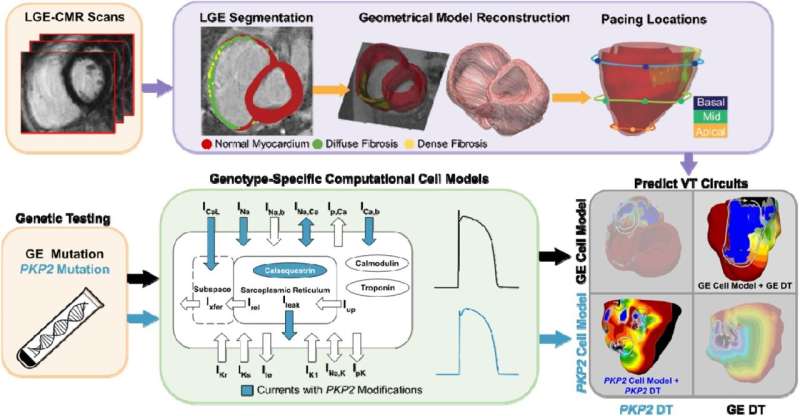This article has been reviewed according to Science X's editorial process and policies. Editors have highlighted the following attributes while ensuring the content's credibility:
fact-checked
peer-reviewed publication
trusted source
proofread
'Digital twins' of patients' hearts harness personal genetics to inform disease management

Scientists have developed a 'genotype-specific digital-twin' strategy, Geno-DT, to create a virtual replica of a patient's heart, providing crucial insights into cardiac health for the diagnosis and treatment of arrhythmogenic right ventricular cardiomyopathy (ARVC).
The research, published today as an eLife Reviewed Preprint, is described by the editors as an important study in the field of personalized medicine. It describes how the authors used state-of-the-art methodologies to create a digital replica of a patient's heart to inform tailored treatments against ARVC.
The new approach could be used to more precisely tailor therapies against ARVC, based on the genetics of the individual patient. It may also act as a generalized framework for improving precision health care in other diseases.
ARVC is an inherited disease of the heart which affects around one in a thousand people, mostly young adults. ARVC can lead to ventricular tachycardia (VT), a disordered heart rhythm that can be life threatening and the disease is associated with around 10% of sudden death cases in people under 65 years old.
Most ARVC cases are associated with mutations in desmosomal genes—a group of genes encoding proteins that form and maintain specialized junctions between cells in the heart and other tissues. Mutations in the gene PKP2 cause distorted electrical conductions in the heart and are the most common source of ARVC, accounting for 60–78% of patients with known genetic variants. Roughly a third of ARVC patients do not have a known causal gene mutation; this is known as gene-elusive ARVC and is typically associated with frequent high-intensity exercise.
"The standard treatment for VTs caused by ARVC is catheter ablation, which delivers energy to disrupt the abnormal heart rhythms. However, difficulties in determining the locations of VTs in the heart mean that ablation in ARVC is not always effective, and they often recur," says lead author Yingnan Zhang, a Ph.D. candidate in the Department of Biomedical Engineering and the Alliance for Cardiovascular Diagnostic and Treatment Innovation, Johns Hopkins University, Maryland, US. "If all VT circuits could be located and defined prior to treatment with catheter ablation, the effectiveness of the procedure could be significantly increased."
In order to solve the challenge of locating VTs in ARVC patients, Zhang and colleagues developed a method for creating a 'genotype-specific digital twin' of an individual's heart, called Geno-DT. This virtual model of a patient's heart can be used to inform diagnosis, treatment planning and predictive analysis of ARVC in a clinical setting.
The digital-twin computational model is tailored to the individual patient by integrating two types of clinical data. Firstly, information on how the patient's heart structure may have been remodeled by the disease can be discerned using Late Gadolinium-Enhanced Magnetic Resonance Image scans. Secondly, the electrophysiological cell model used in the computations can be determined based on the genetic cause of the patient's ARVC.
To validate the effectiveness of Geno-DT, the team conducted a retrospective study of 16 ARVC patients. Half of these patients had mutations in the PKP2 gene, and half had gene-elusive ARVC. The authors created digital twins for each of the 16 patients to analyze the initiation of VTs and better understand the mechanisms that underlie the improper heart rhythms observed in ARVC. Particularly, they sought to determine how differences in an individual's heart structure or electrical activity may contribute to and sustain VTs.
The researchers used Geno-DT to predict the possible locations of VTs in the patients' heart twins. They then verified the accuracy of these predictions by comparing them with the locations of VTs that were clinically observed in the patients' hearts.
The overlap in locations confirmed that Geno-DT can predict VT locations in PKP2 and gene-elusive ARVC with high sensitivity, specificity and accuracy, and in a non-invasive manner. Geno-DT could therefore potentially be used in a clinical setting to identify the ideal candidate locations for catheter ablations, saving time during the procedure and reducing the likelihood of recurrence.
Furthermore, the results revealed that the underlying mechanisms behind VTs in ARVC patients differ based on the genetic cause. In gene-elusive ARVC patients, VTs were primarily induced by fibrotic remodeling—thickening or scarring of the heart tissue caused by the disease.
On the other hand, in PKP2 ARVC, VTs were mostly caused by slowed conduction of electrical signals, and changes to the properties of cardiac tissue in the heart. This finding emphasizes the importance of tailoring treatments against ARVC to the needs of each individual patient, based on their genetic and physical characteristics.
The authors and editors caution that the findings are limited by the small sample size of ARVC patients used in the study. Analyzing additional patients is necessary to validate the statistical significance of the findings. Further studies in this area should also consider other genetic sources of ARVC, such as additional desmosomal genes including DSG2, DSC2 or JUP, to validate the effectiveness of Geno-DT in treating all origins of ARVC.
"Our novel Geno-DT approach has the potential to augment therapeutic precision in the clinical setting and lead to more personalized treatment strategies against ARVC," concludes senior author Natalia Trayanova, a Professor in the Department of Biomedical Engineering, and Director of the Alliance for Cardiovascular Diagnostic and Treatment Innovation, John Hopkins University.
"As our understanding of the genetic variations underlying cardiovascular diseases in humans continues to evolve, Geno-DT could provide a generalized framework to integrate clinical data and improve precision health care for each individual patient."
More information: Yingnan Zhang et al, Predicting Ventricular Tachycardia Circuits in Patients with Arrhythmogenic Right Ventricular Cardiomyopathy using Genotype-specific Heart Digital Twins, eLife (2023). DOI: 10.7554/eLife.88865.1


















